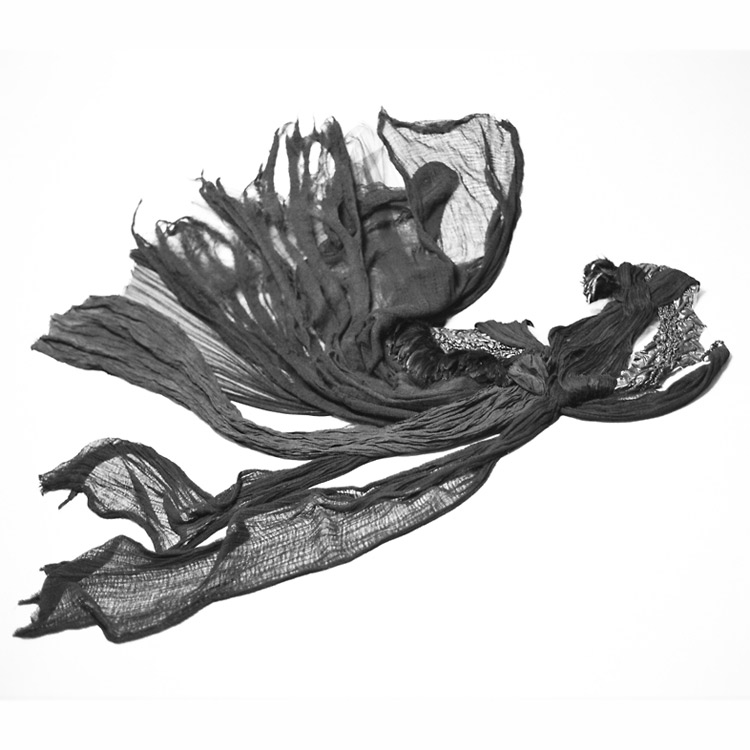Quicktake: Rodarte Exhibit
Cooper-Hewitt curator Gregory Krum on how the Rodarte sisters work together, installing the show, and their many influences

by Anna Carnick
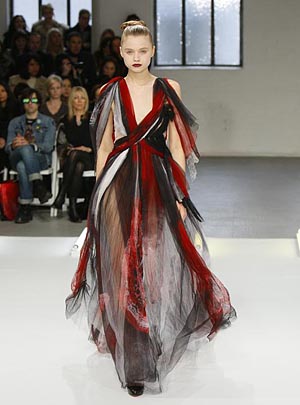
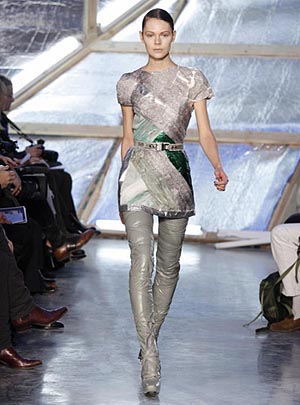
Opening tomorrow, “Quicktake: Rodarte” at the Cooper-Hewitt Design Museum presents an installation celebrating one of fashion’s current dream teams, Rodarte. Sisters Laura and Kate Mulleavy started the label as a passion project, but their experimental, conceptual collections, each more daring than the last, have garnered acclaim among the upper echelons of fashion and on indie blogs alike. Born of eclectic and often surprising inspirations, their garments incorporate elements of haute couture with more radical, often destructive techniques, such as slicing and burning. Their instinctive methods—neither went through formal fashion training—make for an overall ethic that sets them apart from their peers. As curator Gregory Krum puts it, “they approach their work completely on their own terms.”


The exhibit (which runs through 14 March 2010) considers the pair’s process and inspirations on the heels of their award for the 2009 Womenswear Designer of the Year by the Council of Fashion Designers of America and as fashion design finalists for Cooper-Hewitt’s 2009 National Design Awards. CH recently had the pleasure of an interviewing Krum, who explains the museum’s interest in highlighting the talented duo.
What differentiates a “Quicktake” installation from other shows at Cooper-Hewitt?
Most museum shows are scheduled years in advance and we wanted to create a format to address very current work or emerging designers in a timely way. A Quicktake exhibition is basically a small show on a focused theme and organized in under a year. I think this is very exciting and pairs well with Cooper-Hewitt’s larger or more historical exhibitions.
What is it about the Mulleavys inspired the collaboration?
They are clearly creating some of the most exciting work in American fashion. Their particular inspirations and approach to making garments are unusual and fresh, but it’s the finished work—meticulous, sophisticated and fearless—that pushes the conversation forward.

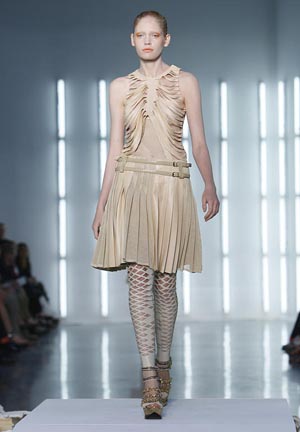
How did this installation come to be?
I had met and worked with them a few years ago and had the exhibition in the back of my mind. Once they won the CFDA award for womenswear and were named a finalist in the National Design Awards, I knew the time was right!
What do you hope the show accomplishes?
It will introduce a whole new population to their work. It’s also a great opportunity to have a closer look at the pieces for those who might only be familiar through runway or editorial images.
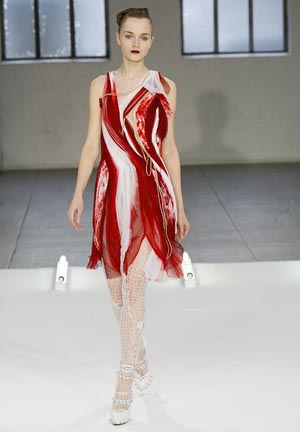
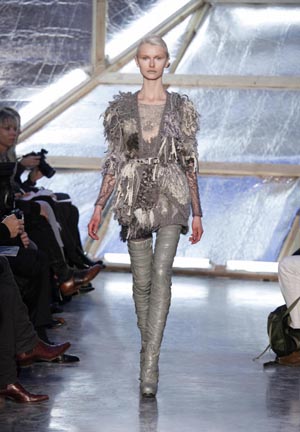
For those less familiar, how would you describe the Mulleavys approach to fashion? Why is this important?
Well, most fundamentally, they approach their work completely on their own terms. They have a very specific vision of what they want to do and are able to combine and convert very disparate references—none of which involve romantic nostalgia for past fashion designers—into garments that don’t look like anything else we’ve seen. Aside from looking unique, the work is constructed in a very serious way, often combining traditional couture techniques with more radical ones…they’ll do whatever it takes to achieve the look they want.
I understand the show will include a selection of pieces from past Rodarte collections as well as a special installation. How were the garments curated and organized for display? Was there a set theme, or did you try to reflect their overall sensibility as a label?
We focused very specifically on the theme of destruction within their work…something they’ve investigated in the past several collections. The garments are organized in three general color groups on three platforms. We selected garments in which fabrics are manipulated in favor of their fascination with the broken, the distressed, the chaotic. The show is not meant to be a retrospective of any kind…more a sustained glimpse at these incredibly strong works amid an atmosphere that both highlights the broken and contrasts the undeniable fineness and beauty of the garments.
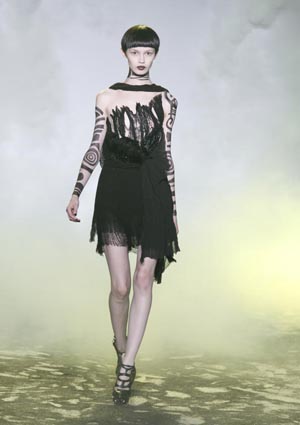

How does the exhibit reveal their process?
Although not necessarily organized chronologically, the progression from the earlier to the most recent work shows their continued process of refinement and risk-taking.
How are their inspirations reflected or presented?
Matt Mazzucca, who designed the installation, worked with Kate and Laura to incorporate some of the themes they are exploring into the presentation, such as chaos, texture, burning, and dilapidation.
How would you describe your experience working with the Mulleavy sisters?
They are inspiring because they are able to distill their disparate interests very clearly. We all actually work very intuitively so, in fact, it was quite easy to bat ideas around and then come to conclusions. For me, what made this so special was the rather seamless collaboration between Kate and Laura, realization experts Black Frame, exhibition designer Matt Mazzucca, and the graphic genius of Patrick Li. Each component was executed with such a rare adroit boldness!
Having worked with the sisters for this project, how would you describe their relationship? How do their talents complement one another?
Read on after the jump.
I very rarely have them in the same room together! But they are so close, they seem to have a collective mind sometimes.
Rodarte is known for balancing soft and hard elements. Can you elaborate on this for us?
You can look at this in terms of any given collection and often within specific outfits. For instance, they’ll make a look completely out of leather, pleating the skirt for softer motion, skin tight leggings with geometric cutouts and a top sliced to look like ribs and a sternum all on top of six-inch heels made of chains and electrical wires. This sort of thing is echoed over and over by the ways they cover and uncover the body and seemingly incongruous but beautiful mix of materials.
How would you describe the way the Mulleavys manipulate fabrics?
Relentless! No fabric is left alone. It’s sliced, cinched, marbled, frayed, burnt, sandpapered, and at the very least, dyed or stained, but only in parts and to a very exacting hue.
There’s always a strong emotion element to their work—how would you describe this?
I think they feel things very strongly. Truman Capote once quoted Marlon Brando as saying, “A sensitive person receives fifty impressions where somebody else may only get seven.” Whatever their inspirations—a horror movie, a cracked desert landscape—they process their multiple impressions into very powerful, relentless work.
The inspirations behind their collections are eclectic and often surprising, and include California Condors, the building and taking apart of homes, Boris Karloff as Frankenstein, land art and Japanese horror films. What ties these themes together?
Not sure that they are, in fact, tied together—more collaged. These inspirations span over the past collections, but it shows a broad curiosity.
Laura studied literature and the modern novel and Kate studied art history at University of California, Berkeley, both graduating in 2001. Do you think these earlier passions are evident in their work today?
Without a doubt. But also their childhood, their parents, growing up somewhat isolated in Northern California, etc. They understand how to parlay all of this into their work. Neither sister had any traditional fashion training.
First, where did their fashion aesthetic and skills come from? And second, how does this benefit them?
I think Kate had some interest in going to fashion school early on, so I’m sure they looked and looked at what was being created. But essentially they are the very rare example of people finding their creative outlet and entering it right away on a very high level. I think in the beginning, even though they did not necessarily know what they were doing, they had the innate knowledge how to proceed in a very, very serious manner. This is quite extraordinary.
According to legend, the Mulleavys came to NYC from Pasadena in 2005 with just a few coats and dresses stuffed in suitcases, and introduced themselves to fashion’s major players. What was it about the pair that got them through the door? How were they able to make their mark so quickly?
I think they had some good advice from a few retailers, but it was really the press that immediately understood the potential of their work. The minute you sit down with them, it’s clear that they are capable of incredible things.
When I think of Rodarte, I think experimental, romantic and fresh. Rodarte’s collaborations with Gap and, more recently, this winter with Target shared their aesthetic with a larger audience. How do you think their style was received on the mass scale?
I think these flew off the shelves! But they really showed themselves to be very adept translators, even of their own work. I know they worked very hard to create garments germane to the fabric and production methods of each project.
Looking back on Rodarte’s fashion from the last five years, how do you think the line and the designers have evolved? Any predictions for the future?
Every season the Mulleavys manage to push themselves further forward. I think they turned a corner with the Fall 2008 collection and were able to see the possibilities of exploring their darker side. I can’t wait to see where it goes!

